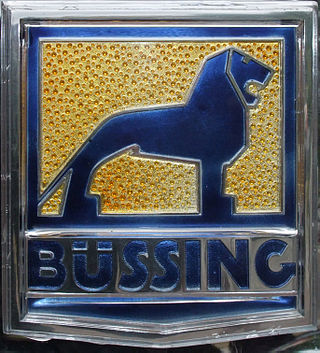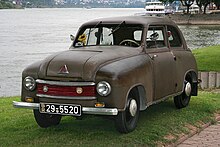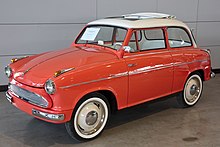
The former Borgward car manufacturing company, based in Bremen, Germany, was founded by Carl F. W. Borgward (1890–1963). It produced cars of four brands, which were sold to a diversified international customer base: Borgward, Hansa, Goliath and Lloyd. Borgward's Isabella was one of the most popular German premium models in the 1950s, while Lloyd's Alexander / Lloyd 600 model offered affordable mobility to many working-class motorists. The group ceased operations in 1961, following controversial insolvency proceedings.

Carl Friedrich Wilhelm Borgward was a German engineer and designer and the creator of the Borgward group, based in Bremen.
Goliath-Werke Borgward & Co. was a German car manufacturer started by Carl F. W. Borgward and Wilhelm Tecklenborg in 1928, and was part of the Borgward group. Goliath was based in Bremen and specialized in three-wheeler cars and trucks and medium-sized cars. Their vehicles were sold under the Goliath brand.
Hansa-Automobil Gesellschaft m.b.H was a German car brand established in 1905, which in 1914 was merged with Norddeutsche Automobil und Motoren AG (NAMAG) into Hansa-Lloyd-Werke A.G.. From 1929 to 1931 it was taken over by the Borgward group. Hansa was based in the Bremen suburb of Hastedt.

Büssing AG was a German bus and truck manufacturer, established in 1903 by Heinrich Büssing (1843–1929) in Braunschweig. It quickly evolved to one of the largest European producers, whose utility vehicles with the Brunswick Lion emblem were widely distributed, especially from the 1930s onwards. The company was taken over by MAN AG in 1971.

The official founding date of the German motor vehicle manufacturer BMW is 7 March 1916, when an aircraft producer called Bayerische Flugzeugwerke was established. This company was renamed to Bayerische Motoren Werke (BMW) in 1922. However, the BMW name dates back to 1917, when Rapp Motorenwerke changed its name to Bayerische Motoren Werke. BMW's first product was a straight-six aircraft engine called the BMW IIIa. Following the end of World War I, BMW remained in business by producing motorcycle engines, farm equipment, household items and railway brakes. The company produced its first motorcycle, the BMW R32, in 1923.

The Borgward Isabella is an automobile which was manufactured by the Bremen based auto-manufacturer Carl F. W. Borgward GmbH from 1954 to 1962.

The Goliath 1100 and later the Hansa 1100 is a small automobile that was manufactured from 1957 until 1961 by the Bremen based Goliath-Werke Borgward & Co, a subsidiary of Borgward. A two-door saloon and a three-door kombi (estate) version were available from launch and a two-door coupe was introduced a year later. For 1959, the Goliath name was discontinued and the car was rebadged as the Hansa 1100, recalling Borgward’s prewar model of the same name.

The Lloyd LT 500 was a compact van produced and sold by the German automaker Borgward Groups's Lloyd Motoren Werke GmbH in Bremen, Germany between 1953 and 1957. A six seater minivan version was offered by April 1954.

The Lloyd LP 250 is a small car introduced in June 1956 and offered for sale until 1957 by Lloyd Motoren Werke G.m.b.H. of Bremen. The body and running gear came from the existing Lloyd LP 400. The LP 250 differed in having the size of its two cylinder two stroke engine reduced to 250 cc. This produced a claimed maximum power of just 8 kW at 5000 rpm, less, even, than the 9.8 kW of the LP 400.

A substantial car industry was created in Australia in the 20th century through the opening of Australian plants by international manufacturers. The first major carmaker was Ford Australia and the first Australian-designed mass production car was manufactured by Holden in 1948. Australian manufacture of cars rose to a maximum of almost half a million in the 1970s and still exceeded 400,000 in 2004. Australia was best known for the design and production of 'large' sized passenger vehicles. By 2009 total production had fallen to around 175,000 and the Australian market was dominated by cars imported from Asia and Europe.

The Glas 1700 is a middle class four door saloon produced by Hans Glas GmbH at Dingolfing. The prototype was first presented in September 1963 at the Frankfurt Motor Show. Later versions of the coupé and cabriolet bodied Glas GT were also powered, in some cases, by the same engine as the saloon. The saloon was produced between August 1964 and December 1967, but the manufacturer never had the investment capital sufficiently to expand production capability and the model was discontinued after the by now badly indebted manufacturer was acquired by BMW.

The Lloyd 600 is a small car produced by the Borgward Groups's Lloyd Motoren Werke GmbH in Bremen between 1955 and 1961.

The Lloyd Arabella was a passenger car produced by the Borgward Group in West Germany between 1959 and 1961. After the company's controversial bankruptcy the Arabella continued to be produced, albeit in greatly reduced quantities and branded as the Borgward Arabella until 1963. By the standards of the time and place it would have been defined as a small family car.

The Lloyd 400 is a small car produced by the Borgward Group's Lloyd Motoren Werke GmbH in Bremen between 1953 and 1957.

The Lloyd 300 was a small car produced by the Borgward Group's Lloyd Motoren Werke GmbH in Bremen between 1950 and 1952.

Borgward Group AG was a Chinese-German automobile brand established in 2010 with headquarters in Stuttgart, Germany. The company carried the name and logo of the former German brand Borgward. Design and engineering was located in Germany, but the cars were produced in China by Foton Motor.

The Goliath F400 is a three-wheeled pickup transporter, made by Hansa-Lloyd and Goliath Company Borgward & Tecklenborg in Bremen, Germany which was sold under the brand Goliath. It was based on the three-wheeled passenger car Goliath Pionier with a closed timber-framed wood cab.
The Hansa 400 is a microcar made in 1933 to 1934 by Hansa Lloyd and Goliath Company, Borgward & Tecklenborg in Bremen, Germany. After about a year in production, it was replaced by the next model Hansa 500 with a bigger engine.
The Blitzkarren was a cab-less tricycle freight cart based on a motorcycle. It was produced in 1924 as the first complete production vehicle manufactured by the Bremer Kühlerfabrik Borgward & Co. GmbH. The company, located in Sebaldsbrück, a settlement in Hemelingen, Bremen, Germany previously produced radiators and fenders for Hansa-Lloyd. Between 1929 and 1931 Hansa-Lloyd was acquired by Carl Borgward and his co-investor Wilhelm Tecklenborg. Borgward also renamed his radiator manufacturing company to Goliath-Werke Borgward & Co. GmbH.























